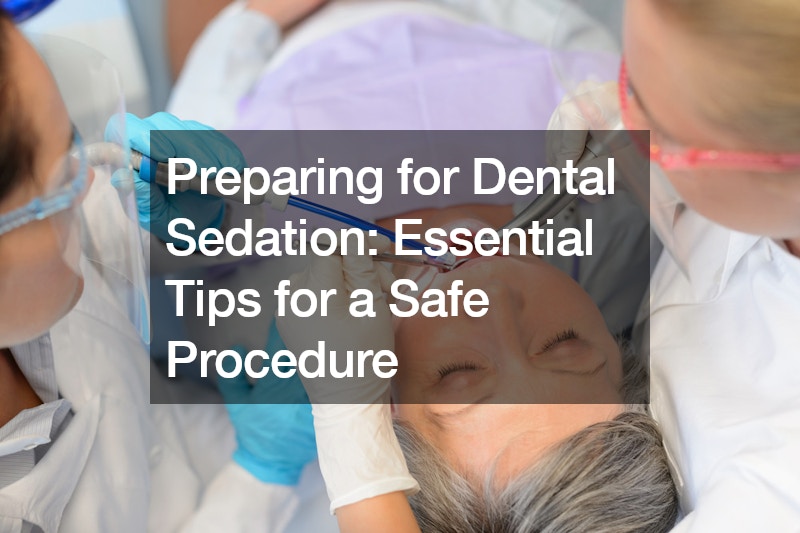Preparing for Dental Sedation Essential Tips for a Safe Procedure

Introduction:
Dental procedures can be anxiety-inducing for many individuals, leading to the growing popularity of sedation dentistry. Whether opting for oral sedation, IV sedation, or general sedation, adequate preparation is key to ensure a safe and comfortable experience. In this comprehensive guide, we will explore essential tips for preparing yourself before a sedation dentistry appointment.
What is Sedation and its Importance in a Dental Procedure:
Sedation in dentistry involves the use of medications to help patients relax during dental procedures. It is especially beneficial for individuals who experience dental anxiety or fear, have a low pain threshold, have sensitive gag reflexes, or require extensive dental work.
Sedation allows patients to undergo necessary dental treatments comfortably and without experiencing excessive stress or discomfort. By inducing a state of relaxation, sedation dentistry enables dentists to perform procedures more efficiently while ensuring patient safety and comfort.
Arrange a Trusted Ride:
One crucial aspect of preparing for dental sedation is arranging reliable transportation to and from the dental office. Having someone you trust to drive you is essential, as the sedative effects can linger even after the procedure. Avoid the temptation to get a ride with a random stranger, prioritizing your safety on this journey.
Dress Comfortably:
Wearing comfortable clothing is often overlooked but plays a vital role in the sedation dentistry process. Opt for attire with short sleeves to facilitate the placement of monitors and potential IV lines. Dental professionals appreciate patients who come prepared in clothing that aids their work, ensuring a smoother experience for everyone involved.
Follow Fasting Guidelines:
Maintaining an empty stomach is a common requirement for various sedation procedures. For oral or IV sedation, abstaining from eating or drinking anything for six to eight hours before the surgery is typically recommended. General anesthesia might extend this fasting period to eight to twelve hours. Adhering to these guidelines is crucial for the effectiveness and safety of the sedation process.
Medication Considerations:
If you are on regular medication, follow your dentist’s instructions regarding its intake on the day of the procedure. In some cases, you may be allowed to take it with small sips of water. However, be cautious not to consume large amounts that might interfere with the sedation process. Some medications used in sedation dentistry can have a rebound effect, causing drowsiness after the initial sedative wears off.
Post-Sedation Precautions:
After the sedation dentistry procedure, it’s imperative to take precautions in the following 24 hours. Due to potential lingering sedative effects, refrain from driving any vehicles and making significant legal decisions during this period. This precautionary measure is in place to ensure your safety and the safety of others, emphasizing the need for a responsible and supportive post-sedation environment.
Communicate Any Deviations:
Open communication with your dentist is crucial throughout the entire process. If, for any reason, you consume food or drink contrary to the fasting guidelines, inform your dentist immediately. This transparency is not only for your safety but also allows the dental team to make informed decisions about adjusting the sedation plan accordingly.
Understand Rebound Sedation Effects:
Some medications used in sedation dentistry may have rebound sedation effects. This means that after feeling initially awake post-procedure, a secondary sedative effect might occur, causing drowsiness again. Consequently, it is advised to avoid driving or making significant decisions for the next 24 hours to mitigate any potential risks associated with these rebound effects.
Importance of Pre-Sedation Consultation:
Before the scheduled sedation dentistry appointment, it is beneficial to have a comprehensive consultation with your dentist. This consultation allows you to discuss any concerns, ask questions about the sedation process, and ensure that you are well-informed about what to expect during and after the procedure.
Creating a Comfortable Environment:
In addition to physical comfort, creating a psychologically comfortable environment is vital for a successful sedation dentistry experience. Bring headphones or soothing music to help relax during the procedure, and discuss any specific comfort measures with your dentist beforehand.
Post-Sedation Follow-Up:
After the procedure, it’s essential to have a post-sedation follow-up with your dentist. This allows the dental team to assess your recovery, address any concerns, and provide postoperative care instructions. Following these instructions diligently contributes to a smooth recovery process.
Conclusion:
In conclusion, preparing for dental sedation is a crucial aspect of ensuring a safe and comfortable experience during your dental procedure. Sedation dentistry has become a valuable option for those seeking relaxation during dental treatments, and by following these essential tips, you can contribute to a smooth and successful sedation experience. Remember to communicate openly with your dentist, adhere to fasting guidelines, prioritize safety both during and after the sedation dentistry appointment, and take advantage of additional measures to enhance your overall comfort throughout the process.
.

